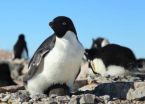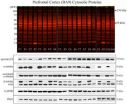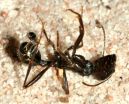(Press-News.org) The Antarctic Peninsula, the northern most region of Antarctica, is experiencing some of the most dramatic changes due to climate warming, including population declines of some penguin species.
This is not the first time that region has felt the effects of climate warming. How did penguins respond to the melting of snow and ice cover 11,000 years ago at the end of the last Ice Age?
Today, scientists have traced the genetics of modern penguin populations back to their early ancestors from the last Ice Age to better understand how three Antarctic penguin species – gentoo, Adélie, and chinstrap penguins – fared in response to past climate change. New evidence shows that in contrast to population trends seen today, the penguin populations in the Antarctic Peninsula grew following the end of the last Ice Age. This new research led by scientists from the University of Southampton, Oxford University, and Woods Hole Oceanographic Institution (WHOI) was published June 12 in the journal Scientific Reports.
Gentoo, Adélie, and chinstrap penguins need land free of ice to nest and raise their young, as well as ice-free access to the ocean in order to be able to forage for food.
"We typically think of penguins as relying on ice, but this research shows that during the last Ice Age there was probably too much ice around Antarctica to support large populations," said lead author Gemma Clucas, from Ocean and Earth Sciences at the University of Southampton (U.K.).
So when the snow and ice began to melt following the end of the last Ice Age, new penguin nesting sites with access to the ocean became available allowing all three species' populations to grow and expand.
"However, despite current warming clearly opening up new opportunities for penguins, we should not assume that rapid warming caused by human activity is good for penguins as a whole," said Clucas.
In fact, today's warming has not been equally advantageous for all three penguin species because of its impact on penguin food supplies. The underside of sea ice serves as a nursery for young krill, shrimp-like crustaceans that feed on algae growing beneath the ice. Decreased sea ice in the Antarctic Peninsula over the past 50 years has brought a reduction in krill, an important food source for penguins. As a result, Adélie and chinstrap penguin populations are dropping at a precipitous rate in the Antarctic Peninsula, according to several recent studies.
"There may be more breeding habitat available now, but there may not be enough food available to sustain those penguin populations which are declining, especially in the Antarctic Peninsula where the warming is the most severe," said co-author Michael Polito, a WHOI post-doctoral investigator.
In contrast, gentoo penguin populations continue to grow. Gentoo penguins forage on a variety of prey. Scientists believe this species may be able to better adapt to shortages in krill, because of their flexible diet.
"What we are seeing is a 'reversal of fortunes' where increased warming is no longer good for two out of the three species of Antarctic Peninsula penguins. This research shows quite clearly how a single environmental change, in this case warming, can have different consequences over time," said Polito.
The scientists collected feather and blood samples from 537 modern penguins in colonies around the Antarctic Peninsula and sequenced the penguins' DNA from these samples. By calculating the rate of mutation, they were able to chart how these populations varied over time in order to result in the genetic diversity and population size exhibited today.
"We are not saying that today's warming climate is good for penguins. In fact, the current decline of some penguin species suggests that the warming climate has gone too far for most penguins," said co-author Tom Hart of the University of Oxford's Department of Zoology.
Within the genetic study of the gentoo species, the scientists saw a variation in population growth between those living north and south of the Antarctic Polar Front, the oceanic dividing line where the cold southern Antarctic waters meet the warmer Atlantic, Pacific, and Indian oceans. Following the last Ice Age, the southern gentoo penguin populations grew at a faster rate than the northern populations. This is most likely because the climate and conditions in the warmer, northern nesting sites did not change as dramatically as the colder, southern sites.
"Without a good understanding of how things were in the past, it's hard to put what we see now into context. This study gives us a historic perspective on a current phenomenon," said Polito.
INFORMATION:
This project included collaborators from the University of Southampton, Oxford University, the British Antarctic Survey, Oceanites Inc., University of North Carolina, Wilmington, and Woods Hole Oceanographic Institution.
The Woods Hole Oceanographic Institution is a private, non-profit organization on Cape Cod, Mass., dedicated to marine research, engineering, and higher education. Established in 1930 on a recommendation from the National Academy of Sciences, its primary mission is to understand the ocean and its interaction with the Earth as a whole, and to communicate a basic understanding of the ocean's role in the changing global environment. For more information, please visit http://www.whoi.edu.
Climate change winners and losers
2014-06-12
ELSE PRESS RELEASES FROM THIS DATE:
Rise and fall of prehistoric penguin populations charted
2014-06-12
A study of how penguin populations have changed over the last 30,000 years has shown that between the last ice age and up to around 1,000 years ago penguin populations benefitted from climate warming and retreating ice. This suggests that recent declines in penguins may be because ice is now retreating too far or too fast.
An international team, led by scientists from the Universities of Southampton and Oxford, has used a genetic technique to estimate when current genetic diversity arose in penguins and to recreate past population sizes. Looking at the 30,000 years before ...
A picture's worth a thousand words
2014-06-12
For nearly 100 years, we have known that type 1 diabetes (T1D) is a disease fundamentally about the progressive loss of insulin-producing beta cells, but measuring that loss has continued to elude researchers—at least until now.
In a recent scientific publication, JDRF-funded researchers used a radiotracer or marker and PET (Positron Emission Tomography) scanning as a non-invasive technique to follow changes in how many active beta cells a person has. Dr. Olle Korsgren and his colleagues at the University of Uppsala in Sweden used the technique in a clinical study ...
Alcohol abuse damage in neurones at a molecular scale identified for first time
2014-06-12
This news release is available in Spanish.
Joint research between the University of the Basque Country (UPV/EHU) and the University of Nottingham has identified, for the first time, the structural damage caused at a molecular level to the brain by the chronic excessive abuse of alcohol. In concrete, the research team has determined the alterations produced in the neurones of the prefrontal zone of the brain (the most advanced zone in terms of evolution and that which controls executive functions such as planning, designing strategies, working memory, selective ...
David and Goliath: How a tiny spider catches much larger prey
2014-06-12
In nature, it is very rare to find a proverbial much smaller David able to overpower and kill a Goliath for supper. This is exactly the modus operandi of a solitary tiny spider from the Negev desert in Israel that routinely kills ants up to almost four times its own size. Details about how it attacks and kills its prey with a venomous bite is published in Springer's journal Naturwissenschaften – The Science of Nature. The study was led by Stano Pekár of Masaryk University in the Czech Republic.
Pekár's team observed the natural prey and predatory behavior of the minute ...
Survivors of childhood liver transplant at risk of becoming 'skinny fat'
2014-06-12
New research reports that survivors of childhood liver transplant remain nutritionally compromised over the long-term. Findings published in Liver Transplantation, a journal of the American Association for the Study of Liver Diseases and the International Liver Transplantation Society, indicate that the recipients' return to normal weight post-transplant was due to an increase in fat mass as body cell mass remained low, indicating a slim body composition with little lean muscle mass or "skinny fat."
Children with end-stage liver disease may be malnourished due to inadequate ...
Scientists closing in on new obesity drug
2014-06-12
Obesity and diabetes are among the fastest growing health problems in the world, and the hunt is in for a pill that can fight the problem. Now a Danish/British team has come up with a smart tool that will speed up the scientific hunting process, and we may be one step closer to a pill against obesity.
The body has a variety of functions that decide if we get overweight or not. For instance hormones control our appetite and the uptake of food. In recent years science has taken on the quest of investigating these physiological functions and finding a medical way to fight ...
Children showing signs of social withdrawal in risk of internalized distress
2014-06-12
Children are showing signs of social withdrawal are more susceptible to parental influences than others. These children were also more prone to distress caused by the impacts of guilt-inducing parenting.
The researchers of the University of Jyväskylä, Finland, have found that children showing signs of social withdrawal are more susceptible to parental influences than others. The researchers followed up about 300 children across the first three years of primary school and monitored the children's social skills and problem behaviors. At the same time, mothers' and fathers' ...
Recreational football can treat hypertensive and type 2 diabetes patients
2014-06-12
The studies, published in the acclaimed Scandinavian Journal of Medicine & Science in Sports, show that 24 weeks of twice-weekly recreational football training sessions lower blood pressure and improves heart function in men with high blood pressure and men with type 2 diabetes. Furthermore, men with type 2 diabetes lost 12 % of their abdominal fat and reduced their blood sugar 20% more than inactive control subjects.
These effects are likely to reduce the risk of developing heart diseases including heart failure and myocardial infarction, and the participants had a reduced ...
Does food addiction exist?
2014-06-12
Women with weight problems were more impulsive than average in a food-related psychology test, a new research paper has shown. This suggested that they are more instinctively stimulated by images of food as well as lacking contemplative will power. Further, some women reported food craving even if they had eaten recently, a symptom of possible food addiction.
"All addictions are similar in that the sufferer craves to excess the feel-good buzz they receive from chemical neurotransmitters produced when they eat, gamble, smoke, have sex or take drugs," commented Claus Voegele, ...
Blood product sterilization taken too far?
2014-06-12
Certain processes used to sterilize blood products could potentially cause serious health issues in transfusion recipients, according to an international study published in the journal Platelets and led by Dr. Patrick Provost of Université Laval's Faculty of Medicine and the CHU de Québec Research Center. These processes purportedly alter the blood platelets to the extent of preventing them from carrying out their functions correctly and may be the cause of hemorrhages observed in patients having received treated blood.
The function of platelets goes far beyond their ...



